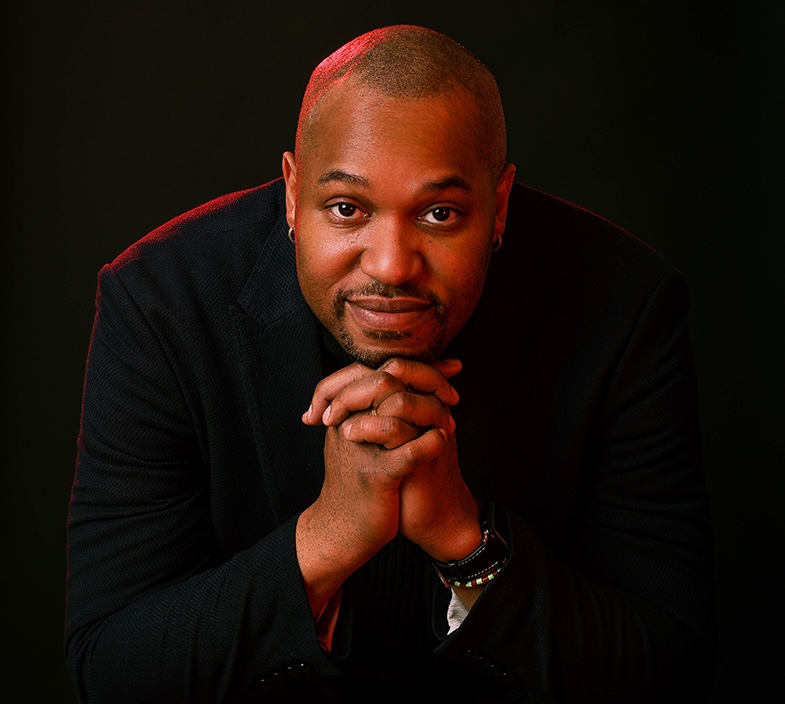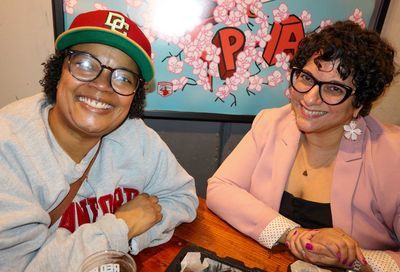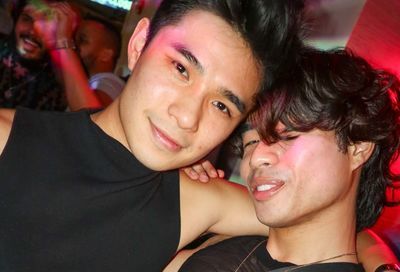Past and Present
ABilly S. Jones on Where We've Been and How We Got Here
There’s no better time to visit with ABilly S. Jones than during October. One on hand, it’s when he celebrates his anniversary with his partner, Christopher Hennin — though Jones argues they should celebrate in June, the month they met. On the other, it’s Gay History Month.
Jones, whose portrait hangs with 27 others at Busboys and Poets till Oct. 19 as part of the Rainbow History Project’s “Community Pioneers” exhibit, has been an important part of the local GLBT community for three decades.
At 65, the bi-identified Jones is not, however, dwelling in the past. He has nine grandchildren to dote upon, and a 30th anniversary with Hennin to plan for 2008. He’s even changing his very identity — one marked by a unique first name, which takes its “A” from a godparent’s initial — by combining his last name with his partner’s, for a soon to be legal “Jones-Hennin” hybrid.
 ABilly S. Jones |
“My ancestors would not be happy if I dropped any of the names. I can’t drop the ‘A’ and I cannot drop the ‘S’ and I cannot drop the ‘Jones.’ People ask ‘How many names are you going to have?’ As many as it takes.”
While Jones’ fingerprints are all over the past, he obviously has no trouble re-crafting himself for his future.
METRO WEEKLY: What brought you to Washington, and when?
ABILLY S. JONES: I came to Washington in the mid ’70s. I’d been living in Columbia, Md., married with kids. I came to Washington for employment reasons, and fell in love with the man I’m in a relationship with now. We met through GAMMA, the Gay Married Men’s Association, of which I was one of the founders. We met 29 years ago in June, actually sitting across from each other, each of us in the arms of someone else, but sort of flirting with each other. We didn’t actually connect until October of the same year.
MW: What was life like for you in D.C. in the late 1970s?
JONES: If you were bisexual, in a heterosexual relationship, when you came to the city from the suburbs you were looking for what the gay life was about. I was not aware at the time of anyone talking about the bisexual community, per se. Looking for gay life primarily meant bars, clubs. You might discover a social organization. You might get connected to private house parties, private events that were by invitation.
I somehow stumbled into the Gay Activists Alliance, as it was called then. I started attending meetings. I noticed that I was the only African-American person attending on a regular basis, and started wondering why. I remember having a discussion with Jim Zais, who has since died of complications related to HIV, an activist in the community very involved with GAA at the time. We were discussing why blacks were not attending what I considered very important political meetings for the community. His response was that several others were trying to figure out the same thing. I said maybe there was something about the organization that just does not appeal to African Americans. That led me to put out an appeal to African Americans to attend an organizing meeting of what was then called the Baltimore-D.C. Coalition of Black Lesbians and Gays. How’s that for a mouthful? It’s affectionately now called the D.C. Coalition.
MW: So the D.C. Coalition was the answer to your questions about GAA, today called the Gay and Lesbian Activists Alliance of Washington, D.C?
JONES: Our feeling at that time was there were a number of social clubs and organizations, and if there were social events there seemed to be no problem getting African Americans to attend. The decision was that we really needed the political organization. About a dozen persons did attend the first meeting in April 1978.
A lot of focus at the beginning was defining ourselves. We went through the process of what to call the organization, how inclusive or exclusive we wanted to be, developing bylaws and what agenda we wanted to address.
The organization turned out to be a progressive organization that right from the beginning included not only gays and lesbians, but also bisexuals and transgenders and allies. The word got out into the community and more and more persons began to attend — not just blacks, but other people of color, allies of the African-American LGBT community. That’s who showed up. At the same time, we made it really clear that this would be an organization that would be addressing African-American LGBT issues. That’s how the tagline, the branding line, came about: “As proud of our gayness as we our of our blackness.”
MW: What were relations like between the black gay community and the white gay community in 1978?
JONES: You have to understand that the position of the movement at that time was that in order to move forward with an LGBT agenda, organizations felt they had to be single-issue organizations. That was hammered home loud and clear — if it wasn’t about gay issues, then it was not their agenda.
Well, if you are a woman, if you are African American, if you are a person of color, if you are a person with a disability, trying to say you are only going to address one issue becomes virtually impossible, or at least very difficult. If you were politically astute, interested in a lot of issues, you’d be going to a lot of meetings to address these various components of yourself. Again, that’s why this coming together of African Americans, persons of African descent, was an important effort. We were pretty much saying that we have to be able to address issues as they relate to African Americans. We have to address homophobia within the black community, and issues of racism within the gay community, and sexism across both communities. It was not about putting one “ism” over the other “ism,” but finding an organization where you could address all of these issues.
Even if we had decided that we were to be a single-issue organization, there was a need for a homogenous organization in the African-American community that would be addressing the issue of homophobia within the black community. None of the other organizations were doing that at that time. What they were doing, if anything, was reacting to homophobia when it surfaced its head and they felt the sting of it coming from the black community. You really have to address homophobia not just when you get stung by it, but even when it’s dormant. You have to address it all times. We still have a lot of work to do.
MW: Within the D.C. Coalition at that time, how tight was the bond between men and women?
JONES: For those women who attended the meetings, there was never any strife between them while I was a member. At the time, there was just a great deal of excitement. I also think that persons of African descent, men and women, have a very different type of relationship with each other than in the white community. There’s a different type of bonding and support of each other, not a lot of the political separatism. If you didn’t want to be with men or didn’t want to be with women, you just didn’t. So those persons who were in a separatist mode just didn’t attend the Coalition meetings.
I had been to enough mainstream organizing meetings where I had experienced men and women screaming, yelling at each other, debating issues of inclusion. We did not go through that. It was always more men than women, and I believe still is the case, but the bylaws at that time had addressed gender parity in terms of leadership.
MW: Another exciting political development of the era was the first National March on Washington for Lesbian and Gay Rights, Oct. 14, 1979, for which you were logistics coordinator.
JONES: I was. It was exciting and tedious and crazy to do both at the same time. We were organizing the Third World Conference for LGBT at the same time that we were supporting and helping to organize the National March on Washington, the first one. It was essentially about 10 of us putting together the Third World Conference.
MW: The mood leading up to the march must’ve been electric.
JONES: It was electric, but I didn’t feel the electricity until the day of the march. [Laughs.] It was exciting in the sense that we thought we could do this with virtually no money, trying to develop funds as we went along. As with all LGBT marches, this was a grassroots effort. We did not have much support from mainstream or national organizations. We had nowhere near enough money to make it happen. Because it was the first effort of this magnitude, there were a number of planning committees that moved from city to city to city for about a year and half to make it happen. Those meetings addressed hardcore issues, like inclusion of transgender in the language that we were using on all promotional materials; issues like the man-boy love issues — the [North American Man/Boy Love Association] was a very strong organization at the time. There were some very intense discussions about inclusion or exclusion of the man-boy movement. Also of the of leather movement.
Keeping the planning committee together and doing that magnitude of outreach on a national level, it was indeed a challenge. We didn’t know, up till the day before, who was going to come and who was not going to come.
MW: Did the actual event meet your expectations?
JONES: It was more than what I expected, but I was exhausted. You’ve got to remember, we had been organizing the LGBT Third World Conference. I had resigned as the logistics coordinator about two weeks prior to the march to focus 100 percent on the Third World Conference. That conference was very much a success, but you could have found me on any given day in a corner, asleep. Someone showed me a photograph from the march where I’d sat under a tree and fallen asleep. That’s how exhausted I was.
MW: Tell me more about the Third World Conference.
JONES: The Third World Conference was the first national gathering of LGBT people of color. For us, it was more important than the March on Washington. You’ve got to remember, this was a gathering of 300 people composed of American-Indian LGBT persons, Latino LGBT persons, Asian LGBT persons, African-American LGBT persons and allies, attending this conference Friday, Saturday and Sunday. And there were caucus groups along gender lines, along racial/ethnic lines, along special-interest lines. There were workshops. Audre Lorde was the keynote speaker. There was a lot going on.
Of course, I was thrilled. One of the things is that the Third World Conference attendees spontaneously decided was to march from Howard University’s Harambee House, as it was called at that time and where we had the conference, down to the Mall, marching straight down Seventh Street. This was on a Sunday when people were going to church, keep in mind. People were curious and they came out. Some applauded. Some just said, “What is this?” We didn’t hear any negative comments. We were all fired up anyway, chanting and carrying on.
MW: How was it named? I would’ve thought you’d call it the “LGBT Person of Color Conference.”
JONES: Why did we call it “Third World”? Because in 1978-79, that was the term that we would’ve used. Our language has changed since then. That was almost 30 years ago. To the same extent, on a social level, rarely will anyone be calling themselves a “homosexual.” The same as we use a different language in terms of race, ethnicity. I prefer calling myself a “person of African descent.” I emerged to that. I’ve gone from calling myself “colored,” to “negro” to “black” to “African American” to “a person of African descent.” Come back and talk to me 10 years from now and I may have a different term for it, but I’ll still be me. [Laughs.]
MW: Do you remember Audre Lorde’s keynote speech?
JONES: You know what? I fell asleep. Look, I was tired. [Laughs.] When you’re at the front line of organizing and even on the day of, you’re running around taking care of small details, dealing with the hotel, and dealing with the attendees and you’re trying to smile, and did I remember to zip up my fly? And do I have the right outfit on? Please! You think I’m going to sit there and listen to a speech? I feel asleep. But I was in the room!
MW: On a different front, what was your response in the early ’80s when GRID, HIV/AIDS by any name, started to hit the community?
JONES: I’m going to speak of it as it related to persons of African descent. There was a great deal of denial. There was a belief, due to lack of information, that this was a gay white disease. African Americans were not the only ones with that belief. In fact, there were some whites who suddenly found blacks sexually more appealing.
We talk about Whitman-Walker Clinic (WWC) organizing, but there were other efforts also. Colevia Carter organized the first women and AIDS conference in the District of Columbia. The same time there was a call out there from WWC, there was also a call within the African-American community. I remember that Gil Gerald organized a meeting to pull together blacks to discuss HIV/AIDS. There were a number of prominent, black gay leaders attending that meeting. There was a great deal of disagreement about the presence of HIV infection in the black-gay community and there were all sorts of arguments just that would not be on the floor today, but persons left that meeting in denial, not believing that HIV/AIDS was a problem in the community. What I can say to you also is that I was not present at that meeting. I know who was present. The only person living today who attended that meeting is Gil Gerald.
I recognized that it was clearly an issue because I had seen the devastation of what we were calling GRID, initially. Then I became involved with the National Coalition [of Black Lesbians and Gays] and we organized the first national conference with Surgeon General C. Everett Koop’s support. That was monumental — the first national effort to address the issue of HIV/AIDS infection in the African American community.
Then I went on to become the social director of the Sunnye Sherman AIDS Education and Prevention Service of the WWC, working very closely with Joseph Izzo who is still at WWC, and others. We were the first AIDS educators and had to develop innovative programs that would work with targeted audiences. The challenge that Joseph Izzo and I had was targeting programs for injection-drug users, male and female sex workers, the homeless population, incarcerated population — what we termed “alienated populations.”
I have remained involved in HIV/AIDS. I’m on the advisory board for the Max Robinson Center and the operating board of HIPS, Helping Individual Prostitutes Survive. Those two organizations are my primary involvement in HIV/AIDS today.
MW: With the organizations you were a part of in the past, do you think those activists from the 1970s and ’80s would be pleased with the here and now?
JONES: Clearly, we’ve made progress in the sense that persons are living much longer with HIV infections. To some degree, we have less of a stigma related to HIV. In terms of the black community, there is certainly more awareness. I don’t think we are doing nearly as much as we could be doing in regard to HIV prevention. The fact that the District has the highest incidence per capita of HIV infections is appalling.
All of us were struggling to understand outside of our own personal box and to be able to expand our thinking on issues. The big issues were discrimination and homophobia as we saw it on the local front and the national front. [Today,] I feel that the D.C. Coalition is still struggling, still lacks a very solid infrastructure that enables it to be taken as a serious organization sometimes. On the plus side, a younger generation is now at the helm. The older activists, we’re taking a step away from the organization, saying it’s time for the younger ones to make this happen.
I am activist till death do I part. Once it gets in your blood, you may step back but you can’t take it away. It’s not just activism as it relates to LGBT issues. I am socially progressive and an activist on any front where I feel activism is needed. I’m either going to step up to the plate, or push someone else to step up to the plate.
Support Metro Weekly’s Journalism
These are challenging times for news organizations. And yet it’s crucial we stay active and provide vital resources and information to both our local readers and the world. So won’t you please take a moment and consider supporting Metro Weekly with a membership? For as little as $5 a month, you can help ensure Metro Weekly magazine and MetroWeekly.com remain free, viable resources as we provide the best, most diverse, culturally-resonant LGBTQ coverage in both the D.C. region and around the world. Memberships come with exclusive perks and discounts, your own personal digital delivery of each week’s magazine (and an archive), access to our Member's Lounge when it launches this fall, and exclusive members-only items like Metro Weekly Membership Mugs and Tote Bags! Check out all our membership levels here and please join us today!






















